All Exams >
Class 10 >
Weekly Tests for Class 10 Preparation >
All Questions
All questions of September Week 2 for Class 10 Exam
Rubber, Tea and coffee come under which type of Industry?
- a)Basic industry
- b)Heavy industry
- c)Agro based industry
- d)Mineral based industry
Correct answer is option 'C'. Can you explain this answer?
Rubber, Tea and coffee come under which type of Industry?
a)
Basic industry
b)
Heavy industry
c)
Agro based industry
d)
Mineral based industry
|
|
Partho Choudhury answered |
Agro-based industries are those industries which obtain raw-material from agriculture. Cotton textile, jute textile, sugar, vegetable oil etc are representative industries of an agro-based group of industry.
New plants can be produces without the help of any reproductive organ by:- a)Vegetative propagation
- b)Regeneration
- c)Budding
- d)Fragmentation
Correct answer is option 'A'. Can you explain this answer?
New plants can be produces without the help of any reproductive organ by:
a)
Vegetative propagation
b)
Regeneration
c)
Budding
d)
Fragmentation

|
Mahi Ashta. answered |
Ofcourse....A is rytt....as vegetative propagation is...an artificial method of.... reproduction in..which the nodes ..of one...plant attached with internodes of other ...plant as not ...of the same plant...
A benefit of plant grown by vegetative propagation is :- a)Lose vigor
- b)Less adaptability to environment
- c)Better quality can be maintained
- d)Induces overcrowding
Correct answer is option 'C'. Can you explain this answer?
A benefit of plant grown by vegetative propagation is :
a)
Lose vigor
b)
Less adaptability to environment
c)
Better quality can be maintained
d)
Induces overcrowding
|
|
Rohan Kapoor answered |
Vegetative propagation is a type of asexual reproduction in plants which produces new organisms and does not involve the production of seeds or spores. It can be natural or can be induced. This type of reproduction is common to have desirable characteristics in a particular group of plants. Vegetative propagation is preferred to sexual reproduction for many reasons but mostly it preferred as it is an easy process and is a faster way to propagation of certain plants. In this method of artificial reproduction there are more amounts of clone produced and is better quality than the actual seedlings.
Advantage of Vegetative Propagation
The main advantage of vegetative propagation methods is that the new plants contain the genetic material of only one parent, so they are essentially clones of the parent plant. This means that, once you have a plant with desirable traits, you can reproduce the same traits indefinitely, as long as the growing conditions remain similar. This is especially important for commercial growers who want to reproduce the highest-quality plants and ensure consistency of a variety of plant or crop for sale. This can also help to maintain consistent quality and taste in products made from plants or crops. For example, in Zealong’s tea plantation, they propagate new tea plants using cuttings to ensure consistency in the taste and quality of their tea.
Iron and steel are :
- a)Agro based industry
- b)Chemical industry
- c)Primary industry
- d)Tertiary industry
Correct answer is option 'C'. Can you explain this answer?
Iron and steel are :
a)
Agro based industry
b)
Chemical industry
c)
Primary industry
d)
Tertiary industry
|
|
Kirti Banerjee answered |
**Iron and steel are basic industries.**
**Explanation:**
**What are Basic Industries?**
Basic industries are those industries that provide the necessary raw materials for other industries and contribute to the overall growth and development of the economy.
**Iron and Steel - A Basic Industry:**
Iron and steel industry is considered a basic industry because it plays a crucial role in the development of various sectors of the economy. It is the foundation and backbone of industrialization and is involved in the production of essential goods required by other industries.
**Raw Material Production:**
1. Iron and steel industry is involved in the extraction of iron ore and coal, which are the primary raw materials required for the production of iron and steel.
2. Iron ore is mined from iron ore reserves and coal is obtained from coal mines.
3. These raw materials undergo various processes like mining, beneficiation, and transportation before they are used in the production of iron and steel.
**Iron and Steel Production:**
1. The iron and steel industry involves the conversion of iron ore into iron, and then further processing it to produce steel.
2. Iron ore is smelted in blast furnaces where it is heated with coke (produced from coal) and limestone to remove impurities and obtain pig iron.
3. The pig iron is then converted into steel through various processes like basic oxygen furnace or electric arc furnace.
**Contribution to Economy:**
1. The iron and steel industry provides the necessary raw materials for the manufacturing of various products like automobiles, machinery, construction materials, etc.
2. It contributes significantly to the GDP (Gross Domestic Product) and employment generation.
3. The industry also has a multiplier effect as it creates demand for other industries like mining, transportation, machinery, etc.
4. It promotes economic growth, export potential, and infrastructure development.
**Conclusion:**
Iron and steel industry is classified as a basic industry because it is involved in the production of essential raw materials required by other industries. It supports industrialization, contributes to the economy, and plays a vital role in the overall development of the country.
**Explanation:**
**What are Basic Industries?**
Basic industries are those industries that provide the necessary raw materials for other industries and contribute to the overall growth and development of the economy.
**Iron and Steel - A Basic Industry:**
Iron and steel industry is considered a basic industry because it plays a crucial role in the development of various sectors of the economy. It is the foundation and backbone of industrialization and is involved in the production of essential goods required by other industries.
**Raw Material Production:**
1. Iron and steel industry is involved in the extraction of iron ore and coal, which are the primary raw materials required for the production of iron and steel.
2. Iron ore is mined from iron ore reserves and coal is obtained from coal mines.
3. These raw materials undergo various processes like mining, beneficiation, and transportation before they are used in the production of iron and steel.
**Iron and Steel Production:**
1. The iron and steel industry involves the conversion of iron ore into iron, and then further processing it to produce steel.
2. Iron ore is smelted in blast furnaces where it is heated with coke (produced from coal) and limestone to remove impurities and obtain pig iron.
3. The pig iron is then converted into steel through various processes like basic oxygen furnace or electric arc furnace.
**Contribution to Economy:**
1. The iron and steel industry provides the necessary raw materials for the manufacturing of various products like automobiles, machinery, construction materials, etc.
2. It contributes significantly to the GDP (Gross Domestic Product) and employment generation.
3. The industry also has a multiplier effect as it creates demand for other industries like mining, transportation, machinery, etc.
4. It promotes economic growth, export potential, and infrastructure development.
**Conclusion:**
Iron and steel industry is classified as a basic industry because it is involved in the production of essential raw materials required by other industries. It supports industrialization, contributes to the economy, and plays a vital role in the overall development of the country.
NTPC is the Abbreviation of which company?
- a)National Textile Production Company
- b)National Technology Production Company
- c)National Thermal Power Corporation
- d)National Tuberculosis Prevention Corporation
Correct answer is option 'C'. Can you explain this answer?
NTPC is the Abbreviation of which company?
a)
National Textile Production Company
b)
National Technology Production Company
c)
National Thermal Power Corporation
d)
National Tuberculosis Prevention Corporation
|
|
Kabir Verma answered |
NTPC Limited, formerly known as National Thermal Power Corporation Limited, is an Indian Public Sector Undertaking, engaged in the business of generation of electricity and allied activities. It is a company incorporated under the Companies Act 1956 and is promoted by the Government of India.
Manufacturing industries includes ___________.
- a)Converting raw material into ready good
- b)Transporting raw material
- c)Producing raw material
- d)Procuring raw material
Correct answer is option 'A'. Can you explain this answer?
Manufacturing industries includes ___________.
a)
Converting raw material into ready good
b)
Transporting raw material
c)
Producing raw material
d)
Procuring raw material
|
|
Kiran Mehta answered |
The branch of manufacture and trade based on the fabrication, processing, or preparation of products from raw materials and commodities. This includes all foods, chemicals, textiles, machines, and equipment.
STP is the Abbreviation of _____.
- a)System tech park
- b)Software Technology Park
- c)State thermal plant
- d)Software Technology Picket
Correct answer is option 'B'. Can you explain this answer?
STP is the Abbreviation of _____.
a)
System tech park
b)
Software Technology Park
c)
State thermal plant
d)
Software Technology Picket

|
S.v. Reddy answered |
Stp: full from is software tech parks of india is under ministry of electronic and information technology. It head quarters in Delhi. Founded in 1991
How does cell division commonly occur in bacteria and protozoa?- a)By unequal splitting during division
- b)By forming multiple daughter cells
- c)By splitting into two equal halves
- d)By developing into spores
Correct answer is option 'C'. Can you explain this answer?
How does cell division commonly occur in bacteria and protozoa?
a)
By unequal splitting during division
b)
By forming multiple daughter cells
c)
By splitting into two equal halves
d)
By developing into spores
|
|
Avi trivedi answered |
Cell Division in Bacteria
Bacteria typically reproduce through a process called binary fission. This method of division is efficient and allows for rapid population growth under favorable conditions.
Key Features of Binary Fission:
- Splitting into Two Equal Halves: In binary fission, the bacterial cell elongates, and the DNA replicates. The cell then divides into two nearly equal halves, each containing a copy of the original DNA. This is why option 'C' is the correct choice.
- Simple Process: The process consists of several stages: DNA replication, cell elongation, septum formation, and division into two daughter cells.
- Rapid Division: Under optimal conditions, bacteria can divide every 20 minutes, making binary fission an effective reproductive strategy.
Cell Division in Protozoa
Protozoa, which are single-celled eukaryotic organisms, also reproduce asexually through various methods, including binary fission, budding, or multiple fission.
Key Features of Protozoan Division:
- Binary Fission: Many protozoa, like bacteria, divide through binary fission, where one cell splits into two equal halves, similar to bacterial division.
- Multiple Fission: Some protozoa can undergo multiple fission, where a single cell divides into several daughter cells simultaneously. This is distinct from binary fission but does not contradict the notion of equal division, as multiple fission can lead to equal-sized daughter cells.
- Variation in Methods: Depending on species and environmental conditions, protozoa may also reproduce through budding or sporulation, but binary fission remains a primary method.
In summary, both bacteria and certain protozoa commonly divide by splitting into two equal halves, which is why option 'C' accurately describes their cell division process.
Bacteria typically reproduce through a process called binary fission. This method of division is efficient and allows for rapid population growth under favorable conditions.
Key Features of Binary Fission:
- Splitting into Two Equal Halves: In binary fission, the bacterial cell elongates, and the DNA replicates. The cell then divides into two nearly equal halves, each containing a copy of the original DNA. This is why option 'C' is the correct choice.
- Simple Process: The process consists of several stages: DNA replication, cell elongation, septum formation, and division into two daughter cells.
- Rapid Division: Under optimal conditions, bacteria can divide every 20 minutes, making binary fission an effective reproductive strategy.
Cell Division in Protozoa
Protozoa, which are single-celled eukaryotic organisms, also reproduce asexually through various methods, including binary fission, budding, or multiple fission.
Key Features of Protozoan Division:
- Binary Fission: Many protozoa, like bacteria, divide through binary fission, where one cell splits into two equal halves, similar to bacterial division.
- Multiple Fission: Some protozoa can undergo multiple fission, where a single cell divides into several daughter cells simultaneously. This is distinct from binary fission but does not contradict the notion of equal division, as multiple fission can lead to equal-sized daughter cells.
- Variation in Methods: Depending on species and environmental conditions, protozoa may also reproduce through budding or sporulation, but binary fission remains a primary method.
In summary, both bacteria and certain protozoa commonly divide by splitting into two equal halves, which is why option 'C' accurately describes their cell division process.
Read the following text and answer the following question on the basis of the same:Authority wants to construct a slide in a city park for children. The slide was to be constructed for children below the age of 12 years. Authority prefers the top of the slide at a height of 4 m above the ground and inclined at an angle of 30° to the ground.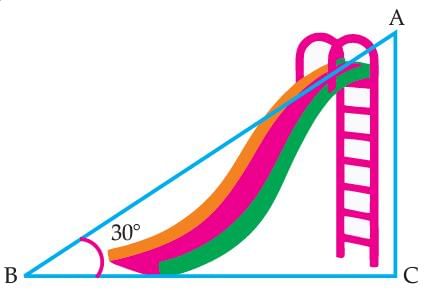 Q. The value of sin2 30° + cos2 60° is:
Q. The value of sin2 30° + cos2 60° is: - a)1 / 4
- b)1 / 2
- c)3 / 4
- d)3 / 2
Correct answer is option 'B'. Can you explain this answer?
Read the following text and answer the following question on the basis of the same:
Authority wants to construct a slide in a city park for children. The slide was to be constructed for children below the age of 12 years. Authority prefers the top of the slide at a height of 4 m above the ground and inclined at an angle of 30° to the ground.

Q. The value of sin2 30° + cos2 60° is:
a)
1 / 4
b)
1 / 2
c)
3 / 4
d)
3 / 2
|
|
Ishan Choudhury answered |
Sin2 30° + cos2 60°
= (1 / 2)2 + (1 / 2)2
= 1 / 4 + 1 / 4
= 2 / 4 = 1 / 2
Manufacturing industries includes :- a)Crop production
- b)Fish production
- c)Plantation
- d)Sugar Production
Correct answer is option 'D'. Can you explain this answer?
a)
Crop production
b)
Fish production
c)
Plantation
d)
Sugar Production
|
|
Avantika Ahuja answered |
Manufacturing industries and Sugar Production
Manufacturing industries refer to those industries which involve the production of goods by transforming raw materials into finished products. Industries such as textiles, chemicals, food processing, machinery, etc., are examples of manufacturing industries.
Sugar production is also a manufacturing industry that involves the processing of sugar cane or sugar beet to produce sugar. The production of sugar involves various stages of processing such as extraction, purification, clarification, evaporation, crystallization, and drying.
Importance of Sugar Production
Sugar production is an important industry as it is a major source of employment and revenue for many countries. It is also an important raw material for the food industry, and is used in the production of various food products such as confectionery, beverages, bakery products, and canned foods.
Additionally, sugar is also used in the production of biofuels, which are becoming increasingly important as a source of renewable energy.
Challenges in Sugar Production
The sugar production industry faces several challenges such as fluctuating prices, competition from alternative sweeteners, and environmental concerns. Additionally, the industry also faces issues related to sustainability, as the production of sugar cane and sugar beet requires large amounts of water and energy and can have negative impacts on soil health and biodiversity.
Conclusion
In conclusion, sugar production is an important manufacturing industry that plays a crucial role in the global economy. Despite the challenges it faces, the industry continues to evolve and adapt to changing market conditions and consumer preferences.
Manufacturing industries refer to those industries which involve the production of goods by transforming raw materials into finished products. Industries such as textiles, chemicals, food processing, machinery, etc., are examples of manufacturing industries.
Sugar production is also a manufacturing industry that involves the processing of sugar cane or sugar beet to produce sugar. The production of sugar involves various stages of processing such as extraction, purification, clarification, evaporation, crystallization, and drying.
Importance of Sugar Production
Sugar production is an important industry as it is a major source of employment and revenue for many countries. It is also an important raw material for the food industry, and is used in the production of various food products such as confectionery, beverages, bakery products, and canned foods.
Additionally, sugar is also used in the production of biofuels, which are becoming increasingly important as a source of renewable energy.
Challenges in Sugar Production
The sugar production industry faces several challenges such as fluctuating prices, competition from alternative sweeteners, and environmental concerns. Additionally, the industry also faces issues related to sustainability, as the production of sugar cane and sugar beet requires large amounts of water and energy and can have negative impacts on soil health and biodiversity.
Conclusion
In conclusion, sugar production is an important manufacturing industry that plays a crucial role in the global economy. Despite the challenges it faces, the industry continues to evolve and adapt to changing market conditions and consumer preferences.
Read the following text and answer the following question on the basis of the same:
Authority wants to construct a slide in a city park for children. The slide was to be constructed for children below the age of 12 years. Authority prefers the top of the slide at a height of 4 m above the ground and inclined at an angle of 30° to the ground.
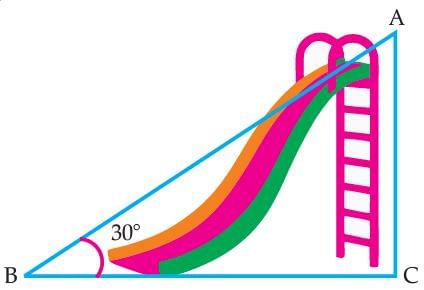 Q. The distance of AB is :
Q. The distance of AB is :
- a)8 m
- b)6 m
- c)5 m
- d)10 m
Correct answer is option 'A'. Can you explain this answer?
Read the following text and answer the following question on the basis of the same:
Authority wants to construct a slide in a city park for children. The slide was to be constructed for children below the age of 12 years. Authority prefers the top of the slide at a height of 4 m above the ground and inclined at an angle of 30° to the ground.

Q. The distance of AB is :
a)
8 m
b)
6 m
c)
5 m
d)
10 m
|
|
Avinash Patel answered |
We have,
∠B = 30° and AC = 4 m
sinθ=p/h or perpendicular/hypotenuse [perpendicular = side directly in front of θ ]
Then, sin 30° = AC / AB
⇒ 1 / 2 = 4 / AB
⇒ AB = 8 m.
Assertion (A): Binary fission in Amoeba can occur in any plane.Reason (R): Amoeba exhibits flexibility in the orientation of cell division.- a)If both Assertion and Reason are true and Reason is the correct explanation of Assertion
- b)If both Assertion and Reason are true but Reason is not the correct explanation of Assertion
- c)If Assertion is true but Reason is false
- d)If both Assertion and Reason are false
Correct answer is option 'A'. Can you explain this answer?
Assertion (A): Binary fission in Amoeba can occur in any plane.
Reason (R): Amoeba exhibits flexibility in the orientation of cell division.
a)
If both Assertion and Reason are true and Reason is the correct explanation of Assertion
b)
If both Assertion and Reason are true but Reason is not the correct explanation of Assertion
c)
If Assertion is true but Reason is false
d)
If both Assertion and Reason are false
|
|
Sneha das answered |
Understanding Binary Fission in Amoeba
Binary fission is a common method of asexual reproduction in unicellular organisms like Amoeba. This process is crucial for their growth and reproduction.
Assertion (A): Binary fission in Amoeba can occur in any plane.
- This statement is true because Amoeba is an irregularly shaped organism with no fixed orientation.
- During binary fission, the cell divides into two daughter cells, and this division can take place in multiple orientations.
Reason (R): Amoeba exhibits flexibility in the orientation of cell division.
- This reason is also true as Amoeba has a flexible cell membrane that allows it to change shape.
- The flexibility enables the organism to divide along any plane, depending on its current shape and environmental conditions.
Relationship Between Assertion and Reason:
- The reason explains why the assertion is true. The flexibility of the Amoeba's structure directly influences its ability to divide in any plane.
- Since both statements are true and the reason accurately explains the assertion, the correct option is (a).
Conclusion:
- The nature of Amoeba allows it to perform binary fission in various orientations due to its flexible structure, making both statements valid and closely linked.
- This understanding emphasizes the adaptability of microorganisms in their reproductive processes.
Binary fission is a common method of asexual reproduction in unicellular organisms like Amoeba. This process is crucial for their growth and reproduction.
Assertion (A): Binary fission in Amoeba can occur in any plane.
- This statement is true because Amoeba is an irregularly shaped organism with no fixed orientation.
- During binary fission, the cell divides into two daughter cells, and this division can take place in multiple orientations.
Reason (R): Amoeba exhibits flexibility in the orientation of cell division.
- This reason is also true as Amoeba has a flexible cell membrane that allows it to change shape.
- The flexibility enables the organism to divide along any plane, depending on its current shape and environmental conditions.
Relationship Between Assertion and Reason:
- The reason explains why the assertion is true. The flexibility of the Amoeba's structure directly influences its ability to divide in any plane.
- Since both statements are true and the reason accurately explains the assertion, the correct option is (a).
Conclusion:
- The nature of Amoeba allows it to perform binary fission in various orientations due to its flexible structure, making both statements valid and closely linked.
- This understanding emphasizes the adaptability of microorganisms in their reproductive processes.
Largest producer of Jute and Jute made goods ?- a)Bangladesh
- b)India
- c)Sri lanka
- d)Brazil
Correct answer is option 'B'. Can you explain this answer?
Largest producer of Jute and Jute made goods ?
a)
Bangladesh
b)
India
c)
Sri lanka
d)
Brazil

|
Akash Banerjee answered |
Introduction to Jute Production
Jute is a natural fiber, often referred to as "golden fiber" due to its color and economic significance. It is primarily cultivated in tropical regions, with Bangladesh and India being the leading producers.
India's Dominance in Jute Production
- Global Leader: India is the largest producer of jute, contributing approximately 40% of the world's total jute production.
- Key States: Major jute-growing states in India include West Bengal, Assam, Odisha, and Andhra Pradesh. West Bengal alone accounts for nearly 70% of India's jute production.
- Cultivation Techniques: Indian farmers utilize traditional and modern farming techniques to cultivate jute, ensuring high yield and quality.
Jute Made Goods Production
- Diverse Products: India is not only the largest producer of raw jute but also excels in producing jute-made goods such as bags, carpets, and textiles.
- Export Potential: The country exports a significant portion of its jute products, boosting its economy and providing employment to millions.
Comparison with Other Countries
- Bangladesh: While Bangladesh is a major player in jute production, it mainly focuses on raw jute rather than finished products.
- Sri Lanka and Brazil: These countries do cultivate jute but on a much smaller scale compared to India and Bangladesh.
Conclusion
India's robust infrastructure, skilled labor, and a long-standing tradition of jute cultivation solidify its position as the largest producer of jute and jute-made goods in the world. This not only enhances its economy but also reinforces its cultural heritage associated with this versatile fiber.
Jute is a natural fiber, often referred to as "golden fiber" due to its color and economic significance. It is primarily cultivated in tropical regions, with Bangladesh and India being the leading producers.
India's Dominance in Jute Production
- Global Leader: India is the largest producer of jute, contributing approximately 40% of the world's total jute production.
- Key States: Major jute-growing states in India include West Bengal, Assam, Odisha, and Andhra Pradesh. West Bengal alone accounts for nearly 70% of India's jute production.
- Cultivation Techniques: Indian farmers utilize traditional and modern farming techniques to cultivate jute, ensuring high yield and quality.
Jute Made Goods Production
- Diverse Products: India is not only the largest producer of raw jute but also excels in producing jute-made goods such as bags, carpets, and textiles.
- Export Potential: The country exports a significant portion of its jute products, boosting its economy and providing employment to millions.
Comparison with Other Countries
- Bangladesh: While Bangladesh is a major player in jute production, it mainly focuses on raw jute rather than finished products.
- Sri Lanka and Brazil: These countries do cultivate jute but on a much smaller scale compared to India and Bangladesh.
Conclusion
India's robust infrastructure, skilled labor, and a long-standing tradition of jute cultivation solidify its position as the largest producer of jute and jute-made goods in the world. This not only enhances its economy but also reinforces its cultural heritage associated with this versatile fiber.
Read the following text and answer the following question on the basis of the same:'Skysails' is that genre of engineering science that uses extensive utilization of wind energy to move a vessel in the sea water. The sky sails technology allows the towing kite to gain a height of anything between 100 m to 300 m. The sailing kite is made in such a way that it can be raised to its proper elevation and then brought back with the help of a telescopic mast that enables the kite to be raised properly and effectively.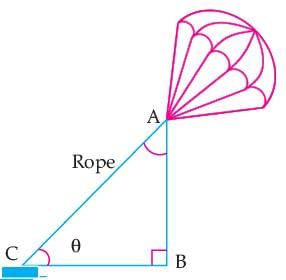 Q. What should be the length of the rope of the kite sail in order to pull the ship at the angle θ and be at a vertical height of 200 m?
Q. What should be the length of the rope of the kite sail in order to pull the ship at the angle θ and be at a vertical height of 200 m?- a)400 m
- b)300 m
- c)100 m
- d)200 m
Correct answer is option 'A'. Can you explain this answer?
Read the following text and answer the following question on the basis of the same:
'Skysails' is that genre of engineering science that uses extensive utilization of wind energy to move a vessel in the sea water. The sky sails technology allows the towing kite to gain a height of anything between 100 m to 300 m. The sailing kite is made in such a way that it can be raised to its proper elevation and then brought back with the help of a telescopic mast that enables the kite to be raised properly and effectively.

Q. What should be the length of the rope of the kite sail in order to pull the ship at the angle θ and be at a vertical height of 200 m?
a)
400 m
b)
300 m
c)
100 m
d)
200 m
|
|
Rohit Sharma answered |
In ΔABC, we have
θ = 30°, AB = 200 m
Then, sin 30° = Perpendicular / Hypotenuse
= AB / AC
⇒ 1 / 2 = 200 / AC
⇒ AC = 400 m.
Read the following text and answer the following question on the basis of the same:'Skysails' is that genre of engineering science that uses extensive utilization of wind energy to move a vessel in the sea water. The sky sails technology allows the towing kite to gain a height of anything between 100 m to 300 m. The sailing kite is made in such a way that it can be raised to its proper elevation and then brought back with the help of a telescopic mast that enables the kite to be raised properly and effectively.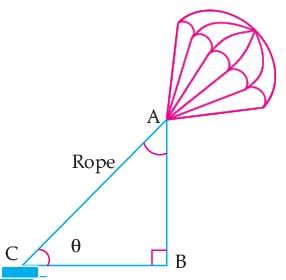 Q. If cos A = 1/ 2 , then the value of 9 cot2 A – 1 is:
Q. If cos A = 1/ 2 , then the value of 9 cot2 A – 1 is:- a)1
- b)3
- c)2
- d)4
Correct answer is option 'C'. Can you explain this answer?
Read the following text and answer the following question on the basis of the same:
'Skysails' is that genre of engineering science that uses extensive utilization of wind energy to move a vessel in the sea water. The sky sails technology allows the towing kite to gain a height of anything between 100 m to 300 m. The sailing kite is made in such a way that it can be raised to its proper elevation and then brought back with the help of a telescopic mast that enables the kite to be raised properly and effectively.

Q. If cos A = 1/ 2 , then the value of 9 cot2 A – 1 is:
a)
1
b)
3
c)
2
d)
4
|
|
Naina Sharma answered |
Given, cos A = 1/ 2
⇒ cos A = cos 60°
⇒ A = 60°
Then, 9 cot2 A – 1 = 9(cot 60°)2 – 1

= 2
Read the following text and answer the following question on the basis of the same:Authority wants to construct a slide in a city park for children. The slide was to be constructed for children below the age of 12 years. Authority prefers the top of the slide at a height of 4 m above the ground and inclined at an angle of 30° to the ground.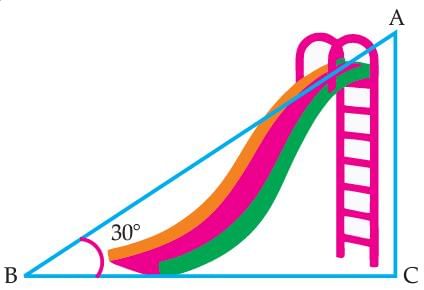 Q. If cos A = 1 / 2 , then the value of 12 cot2 A – 2 is:
Q. If cos A = 1 / 2 , then the value of 12 cot2 A – 2 is:- a)5
- b)4
- c)3
- d)2
Correct answer is option 'D'. Can you explain this answer?
Read the following text and answer the following question on the basis of the same:
Authority wants to construct a slide in a city park for children. The slide was to be constructed for children below the age of 12 years. Authority prefers the top of the slide at a height of 4 m above the ground and inclined at an angle of 30° to the ground.

Q. If cos A = 1 / 2 , then the value of 12 cot2 A – 2 is:
a)
5
b)
4
c)
3
d)
2
|
|
Kiran Mehta answered |
Cos A = 1 / 2
⇒ cos A = cos 60°
⇒ A = 60°
Then 12 cot2 A – 2 = 12(cot 60°) – 2

= 4 – 2 = 2.
Read the following text and answer the following question on the basis of the same:
Authority wants to construct a slide in a city park for children. The slide was to be constructed for children below the age of 12 years. Authority prefers the top of the slide at a height of 4 m above the ground and inclined at an angle of 30° to the ground.
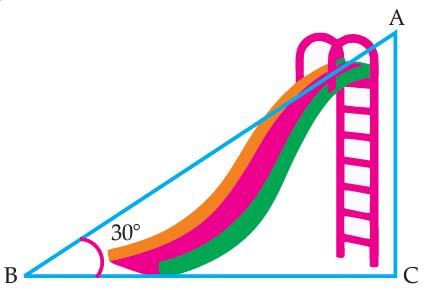 Q. In the given figure, if AB + BC = 25 cm and AC = 5 cm, then the value of BC is:
Q. In the given figure, if AB + BC = 25 cm and AC = 5 cm, then the value of BC is:
- a)25 cm
- b)15 cm
- c)10 cm
- d)12 cm
Correct answer is option 'D'. Can you explain this answer?
Read the following text and answer the following question on the basis of the same:
Authority wants to construct a slide in a city park for children. The slide was to be constructed for children below the age of 12 years. Authority prefers the top of the slide at a height of 4 m above the ground and inclined at an angle of 30° to the ground.

Q. In the given figure, if AB + BC = 25 cm and AC = 5 cm, then the value of BC is:
a)
25 cm
b)
15 cm
c)
10 cm
d)
12 cm
|
|
Vivek Rana answered |
We have,
∠C = 90°
AB + BC = 25 cm and AC = 5 cm
Let BC be x cm, then AB = (25 – x) cm
By using Pythagoras theorem,
AB2 = BC2 + AC2
⇒ (25 – x2) = x2 + (5)2
⇒ 625 – 50x + x2 = x2 + 25
⇒ 50x = 600
⇒ x = 600 / 50 = 12
Hence, BC = 12 cm
Read the following text and answer the following question on the basis of the same:Authority wants to construct a slide in a city park for children. The slide was to be constructed for children below the age of 12 years. Authority prefers the top of the slide at a height of 4 m above the ground and inclined at an angle of 30° to the ground.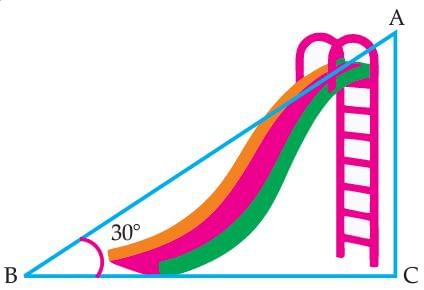 Q. In the given figure, the value of (sin C × cos A) is:
Q. In the given figure, the value of (sin C × cos A) is:- a)1 / 3
- b)1/2
- c)1 / 4
- d)1 / 5
Correct answer is option 'B'. Can you explain this answer?
Read the following text and answer the following question on the basis of the same:
Authority wants to construct a slide in a city park for children. The slide was to be constructed for children below the age of 12 years. Authority prefers the top of the slide at a height of 4 m above the ground and inclined at an angle of 30° to the ground.

Q. In the given figure, the value of (sin C × cos A) is:
a)
1 / 3
b)
1/2
c)
1 / 4
d)
1 / 5

|
Kds Coaching answered |
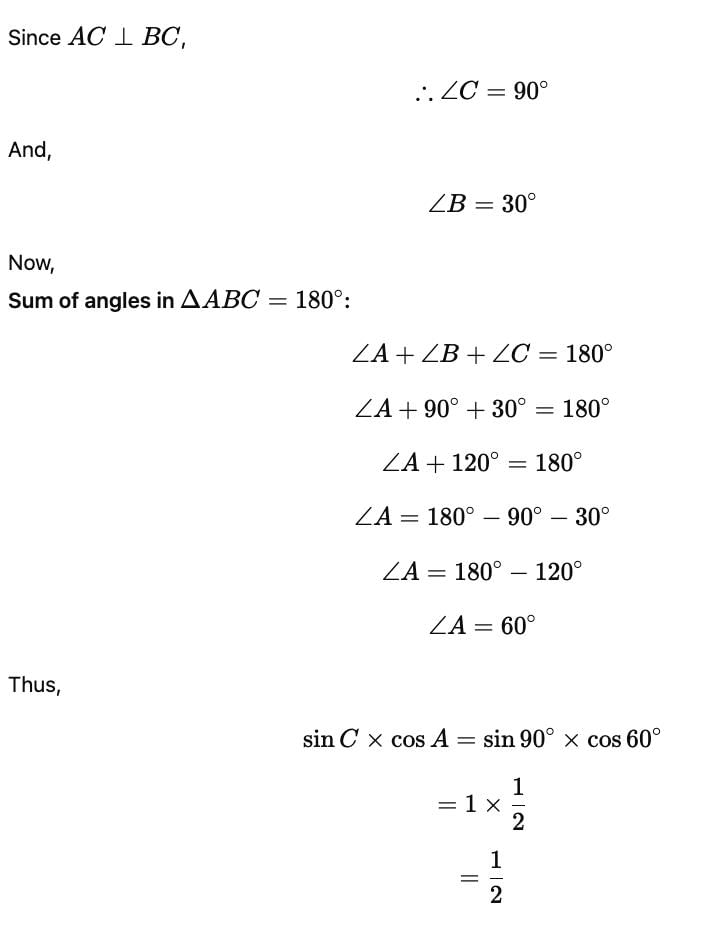
Read the following text and answer the following question on the basis of the same:'Skysails' is that genre of engineering science that uses extensive utilization of wind energy to move a vessel in the sea water. The sky sails technology allows the towing kite to gain a height of anything between 100 m to 300 m. The sailing kite is made in such a way that it can be raised to its proper elevation and then brought back with the help of a telescopic mast that enables the kite to be raised properly and effectively.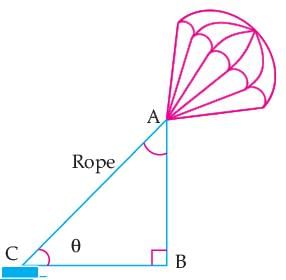 Q. In the given figure, if tan θ = cot (30° + θ), where θ and 30° + θ are acute angles, then the value of θ is:
Q. In the given figure, if tan θ = cot (30° + θ), where θ and 30° + θ are acute angles, then the value of θ is: - a)45°
- b)30°
- c)60°
- d)None of these
Correct answer is option 'B'. Can you explain this answer?
Read the following text and answer the following question on the basis of the same:
'Skysails' is that genre of engineering science that uses extensive utilization of wind energy to move a vessel in the sea water. The sky sails technology allows the towing kite to gain a height of anything between 100 m to 300 m. The sailing kite is made in such a way that it can be raised to its proper elevation and then brought back with the help of a telescopic mast that enables the kite to be raised properly and effectively.

Q. In the given figure, if tan θ = cot (30° + θ), where θ and 30° + θ are acute angles, then the value of θ is:
a)
45°
b)
30°
c)
60°
d)
None of these
|
|
Aditya Shah answered |
Given, tan θ = cot(30° + θ)
= tan[90° – (30° + θ)]
= tan(90° – 30° – θ)
⇒ tan θ = tan(60° – θ)
⇒ θ = 60° – θ
⇒ 2θ = 60°
⇒ θ = 30°.
Read the following text and answer the following question on the basis of the same:'Skysails' is that genre of engineering science that uses extensive utilization of wind energy to move a vessel in the sea water. The sky sails technology allows the towing kite to gain a height of anything between 100 m to 300 m. The sailing kite is made in such a way that it can be raised to its proper elevation and then brought back with the help of a telescopic mast that enables the kite to be raised properly and effectively.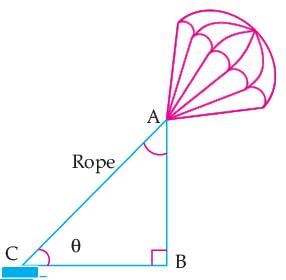 Q. The value of tan 30°. cot 60° is:
Q. The value of tan 30°. cot 60° is: - a)√3
- b)1 / √3
- c)1
- d)1 / 3
Correct answer is option 'D'. Can you explain this answer?
Read the following text and answer the following question on the basis of the same:
'Skysails' is that genre of engineering science that uses extensive utilization of wind energy to move a vessel in the sea water. The sky sails technology allows the towing kite to gain a height of anything between 100 m to 300 m. The sailing kite is made in such a way that it can be raised to its proper elevation and then brought back with the help of a telescopic mast that enables the kite to be raised properly and effectively.

Q. The value of tan 30°. cot 60° is:
a)
√3
b)
1 / √3
c)
1
d)
1 / 3
|
|
Ishan Choudhury answered |
Tan 30° × cot 60°
= 1 / √3 x 1 / √3
= 1 / 3.
Read the following text and answer the following question on the basis of the same:
'Skysails' is that genre of engineering science that uses extensive utilization of wind energy to move a vessel in the sea water. The sky sails technology allows the towing kite to gain a height of anything between 100 m to 300 m. The sailing kite is made in such a way that it can be raised to its proper elevation and then brought back with the help of a telescopic mast that enables the kite to be raised properly and effectively. Where AB=200m and AC=400m
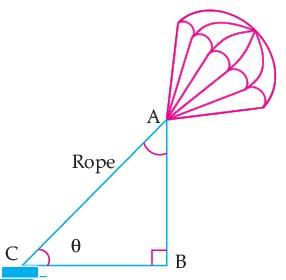 Q. In the given figure, the value of (sin C + cos A) is:
Q. In the given figure, the value of (sin C + cos A) is:
- a)1
- b)2
- c)3
- d)4
Correct answer is option 'A'. Can you explain this answer?
Read the following text and answer the following question on the basis of the same:
'Skysails' is that genre of engineering science that uses extensive utilization of wind energy to move a vessel in the sea water. The sky sails technology allows the towing kite to gain a height of anything between 100 m to 300 m. The sailing kite is made in such a way that it can be raised to its proper elevation and then brought back with the help of a telescopic mast that enables the kite to be raised properly and effectively. Where AB=200m and AC=400m

Q. In the given figure, the value of (sin C + cos A) is:
a)
1
b)
2
c)
3
d)
4
|
|
Naina Sharma answered |
We have,
AB = 200 m and AC = 400 m Proved in Q.3]
Then, sin C + cos A

Chapter doubts & questions for September Week 2 - Weekly Tests for Class 10 Preparation 2025 is part of Class 10 exam preparation. The chapters have been prepared according to the Class 10 exam syllabus. The Chapter doubts & questions, notes, tests & MCQs are made for Class 10 2025 Exam. Find important definitions, questions, notes, meanings, examples, exercises, MCQs and online tests here.
Chapter doubts & questions of September Week 2 - Weekly Tests for Class 10 Preparation in English & Hindi are available as part of Class 10 exam.
Download more important topics, notes, lectures and mock test series for Class 10 Exam by signing up for free.

Contact Support
Our team is online on weekdays between 10 AM - 7 PM
Typical reply within 3 hours
|
Free Exam Preparation
at your Fingertips!
Access Free Study Material - Test Series, Structured Courses, Free Videos & Study Notes and Prepare for Your Exam With Ease

 Join the 10M+ students on EduRev
Join the 10M+ students on EduRev
|

|
Create your account for free
OR
Forgot Password
OR
Signup to see your scores
go up within 7 days!
Access 1000+ FREE Docs, Videos and Tests
Takes less than 10 seconds to signup











